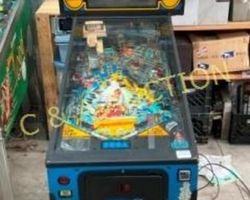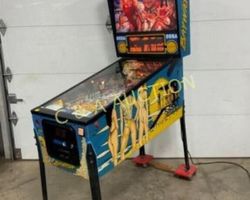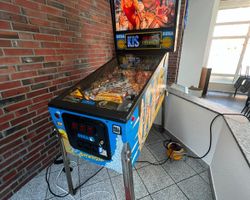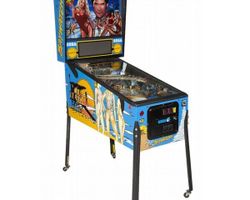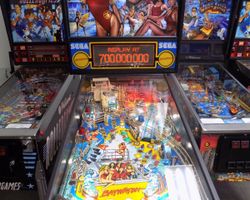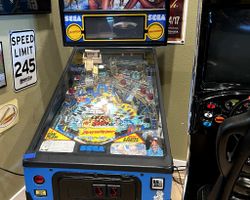Baywatch
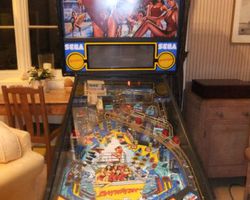
Average Prices: USD $600 to $2,200
Produced: Febuary, 1995
Machine Type: Solid State Electronic
MPU: DataEast/Sega Version 3b
Players: 6
Design by: Joe Kaminkow, Joe Balcer
Art by: Markus Rothkranz, Jeff Busch
Dots/Animation by: Kurt Andersen, Jack Liddon, Marc Raneses
Music by: Brian Schmidt
Sound by: Brian Schmidt
Software by: John Carpenter, Neil Falconer, Orin Day, Lonnie D. Ropp
The allure of the beachfront and the drama of rescue missions found a unique translation into the world of pinball with the arrival of Baywatch, a machine brought to life by Sega Pinball, Inc. in February 1995. This solid-state electronic (SS) game, model number 33, emerged from the Data East/Sega Version 3b MPU generation, designed to capture the attention of a broad audience. The inspiration for the machine was clear: the globally popular television series, known for its sun-drenched settings and compelling character arcs.
The creative team behind Baywatch was a collaborative effort, bringing together various talents essential to pinball machine development. The core design was shaped by Joe Balcer and Joe Kaminkow, individuals whose visions guided the overall playfield layout and gameplay concepts. The distinctive visual identity of Baywatch pinball stemmed from the artistic contributions of Jeff Busch and Markus Rothkranz, who translated the show's aesthetic into the playfield and cabinet artwork. Complementing the visuals, Brian Schmidt was responsible for the machine's music and sound design, crafting an auditory experience that immersed players in the theme. Software development, crucial for game logic and interactivity, was handled by a team including John Carpenter, Lonnie D. Ropp, Neil Falconer, and Orin Day. Animation for the advanced Dot Matrix Display (DMD) was created by Jack Liddon and Kurt Andersen, while the intricate mechanical systems were engineered by John Borg. With approximately 2,000 units produced, Baywatch entered the market aiming to deliver a year-round summer experience on the pinball playfield. One interesting detail from the production period is that during the match sequence, a unique "squid girl" can rarely appear holding the match number, a subtle nod to the machine's playful nature.
Signature Features and Design
Baywatch pinball differentiates itself through several standout features that enhance both its visual appeal and its gameplay experience. A prominent design element is the presence of four flippers: three standard-sized flippers and a unique, game-controlled mini-flipper known as "Shark Flips." This mini-flipper, adorned with a plastic shark fin, is centrally located and adds an unexpected, dynamic element to ball control, activating at specific moments to alter playfield trajectory, a mechanism that provides an element of surprise and challenge similar to other renowned pinball innovations where flippers activate independently.
The machine's visual storytelling is amplified by its larger-than-standard Dot Matrix Display (DMD), measuring 192x64 pixels. This generous display size allowed for more detailed animations and video modes, a significant advantage for theme integration. The animations, crafted by Jack Liddon and Kurt Andersen, bring characters and scenarios from the television series to life, enhancing player immersion during various game modes and events. Custom speech further integrates the theme, with character voices and thematic callouts guiding players through objectives. The 'Baywatch Lock Tower' in the upper left corner of the playfield serves as a physical ball lock mechanism, a key component for initiating multiball play. Additionally, a backbox topper provides a striking visual accent, contributing to the machine's overall presence in an arcade or collection. The trap door on the left plastic ramp offers another interactive element, diverting the ball's path unpredictably, adding to the game's flow and creating opportunities for varied shots. The left outlane kickback is a welcome feature, providing a chance for players to save a draining ball, while right dual inlanes offer strategic routing options.
Playfield and Mechanics
The Baywatch pinball playfield is a meticulously designed landscape, balancing open areas for fluid shots with intricate mechanisms that demand precision. Four distinct ramps dominate the layout, providing exhilarating long shots and contributing significantly to the machine's overall flow. The main ramp structures allow for consistent ball return to the flippers, fostering a rhythm of continuous play. Three pop bumpers, referred to in the manual as "Turbo bumpers," are strategically placed to create chaotic, high-scoring action in the upper playfield. Their energetic deflections can send the ball into various targets or towards the ramps, creating dynamic sequences.
The lower playfield is anchored by two slingshots that propel the ball across the flipper area with force, adding to the game's speed. Twelve standup targets are spread throughout the playfield, encouraging players to explore different shot angles for progression. A 3-bank drop target setup presents a more direct objective, requiring focused shots to clear. A spinning target adds a variable scoring element, rewarding players who hit it multiple times for increased point values. A scoop target and a vertical up-kicker are integrated into the layout, serving as entry points for modes, multiball, or skill shots.
The design philosophy behind the Baywatch playfield emphasizes high shot density and varied paths, encouraging players to engage with the entire layout rather than focusing on a single loop. This approach, combined with the presence of multiple flippers, creates an engaging and dynamic experience. The artwork by Jeff Busch and Markus Rothkranz captures the vibrant, sun-soaked atmosphere of the Baywatch theme. Bright blues, yellows, and reds dominate the aesthetic, depicting beach scenes, lifeguard towers, and characters, all illuminated by well-placed lighting. The comprehensive lighting scheme works in tandem with the playfield elements, guiding the player's eye towards active objectives and highlighting successful shots, further immersing them in the coastal rescue narrative.
Gameplay Dynamics
Baywatch pinball features a comprehensive gameplay experience driven by a deep ruleset for its era, offering players multiple paths to progression and high scores. The game initiates with an autoplunger, ensuring consistent skill shot opportunities from the outset. Players are encouraged to hit specific targets or ramps during the plunge to gain an early advantage. The core gameplay revolves around activating various modes and working towards multiball, with the ultimate goal of reaching a demanding wizard mode.
One of the central attractions is the 5-ball multiball, a chaotic and high-scoring event that requires players to lock balls in the 'Baywatch Lock Tower' and other mechanisms. During multiball, players aim to hit lit jackpot targets to maximize their score, often leading to frantic flipper action. The machine features two distinct video modes presented on the large DMD, offering a change of pace from traditional pinball mechanics. These interactive sequences provide additional scoring opportunities and thematic integration, such as navigating a jet ski or rescuing swimmers.
The game's objectives are multifaceted, encouraging players to complete mode objectives, collect awards, and hit specific shot combinations. For example, completing a bank of drop targets might activate a specific rescue mission, or successfully shooting a ramp multiple times could light a valuable shot. The "Shark Flips" mini-flipper introduces an element of strategic unpredictability, as its activation can create unexpected shot opportunities or ball saves, demanding player adaptability. Success in Baywatch often involves mastering the game's flow, stringing together ramp shots and target hits, while also being prepared for the intermittent chaos induced by the pop bumpers and the unique flipper. The progression system leads players through various "rescue missions" and objectives, culminating in a challenging wizard mode that tests a player's ability to manage multiple balls and hit precise shots under pressure, providing a satisfying long-term goal.
Reception and Legacy
Baywatch pinball has garnered a generally positive reception within the pinball community, often being cited as an underrated machine that surpasses initial expectations based on its theme alone. Many players who approach it with reservations regarding the licensed subject matter frequently report surprise at its engaging and satisfying gameplay. Its strengths are frequently highlighted as an excellent playfield design, boasting a wide variety of shots that feel smooth and rewarding to execute. The four flippers, particularly the distinctive "Shark Flips" mechanism, add a layer of complexity and interest to ball control, contributing to the game's dynamic feel.
Players consistently praise Baywatch for its good flow and fast-paced gameplay, making it an addictive experience. The ruleset, considered deep for a machine of its era, offers ample replay value through its diverse modes and objectives, including a challenging wizard mode that provides a clear long-term goal. The large DMD with its well-executed animations is also a frequent point of appreciation, enhancing the thematic immersion. For many, Baywatch represents strong value, offering a rich gameplay experience at an accessible price point, particularly with community-driven software updates often mentioned as improving the overall experience.
However, the machine is not without its criticisms. The most common drawback cited is the Baywatch theme itself, which some players find cheesy, dated, or simply unappealing, overshadowing the gameplay for a segment of the audience. The artwork, especially the translite, occasionally receives criticism for its portrayal of the show's cast. Some sound design elements and music tracks are also occasionally described as dated or lacking in quality compared to contemporaries. Maintenance can sometimes be a consideration, with some collectors noting the game can be intricate to service. Despite these points, Baywatch's reputation as a "sleeper hit" persists, celebrated for its robust mechanics and enjoyable playfield. Its legacy lies in its ability to transcend its theme for many, proving that a solid layout, creative mechanisms like the software-controlled mini-flipper, and a well-structured ruleset can overcome perceived thematic limitations, maintaining its position as a surprising and fun entry in the pinball catalog.
Sponsored Links
 Ebay Listings
Ebay Listings
 Auction Results
Auction Results
| Cost | Location | Date |
|---|---|---|
| USD $3,800 |  Michigan, United States Michigan, United States |
15 November, 2025 |
| USD $4,000 |  Colorado, United States Colorado, United States |
27 September, 2025 |
| USD $4,400 |  Kentucky, United States Kentucky, United States |
08 July, 2025 |
| EUR €2,930 |  Niedersachsen, Germany Niedersachsen, Germany |
30 October, 2024 |
| USD $1,980 |  Arizona, United States Arizona, United States |
04 August, 2024 |
| USD $3,999 |  Florida, United States Florida, United States |
15 July, 2024 |
| USD $2,600 |  North Carolina, United States North Carolina, United States |
14 July, 2024 |
| USD $4,950 |  New Mexico, United States New Mexico, United States |
24 June, 2024 |
| USD $4,400 |  South Dakota, United States South Dakota, United States |
22 May, 2024 |
| USD $4,100 |  Illinois, United States Illinois, United States |
26 January, 2024 |


Private Policy · Search Website · Contact Us
As an eBay Partner, we may earn a commission from qualifying purchases made through links on this site, at no additional cost to you.
All trademarks and copyrighted materials remain property of their respective owners. All other content copyright 2007 - 2025 Pinpedia.

